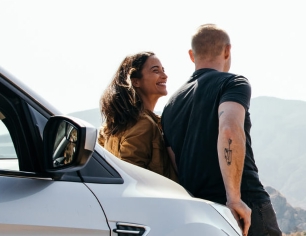Who's at fault in a side-impact collision?
If you're involved in a side-impact collision and were following the rules of the road, your first instinct will likely be that the other driver is at fault. Even if they were driving recklessly or made an apparent mistake, proving fault in a side collision can still be lengthy. Understand the nature of side-impact car accidents to navigate how to handle these types of collisions.
Explore Progressive Answers' auto editorial guidelines to find out why you can trust the car insurance information you find here.
What are side-impact collisions?
A side-impact crash is any collision in which one vehicle crashes into the side of another. T-bone car accidents, also called right-angle collisions, occur when one vehicle's front strikes another vehicle's side and are typically associated with intersections where drivers run red lights or stop signs. Even at relatively slow speeds, parking lot collisions can lead to t-boned cars. Sideswipes on highways or roads are side collisions as well.
Why side-impact collisions are often serious
A side-impact collision can cause severe or even fatal injuries because drivers may not be aware of the incoming collision and therefore might be unable to brake or steer away to prevent the strike. The point of impact is closer to the driver when the crash occurs, potentially leading to broken bones and head injuries. According to the Insurance Institute for Highway Safety (IIHS), vehicle-side impacts caused 23 percent of passenger-occupant deaths in 2020.
Practicing defensive driving, keeping up on vehicle maintenance, maintaining a safe distance from other cars, driving within the speed limit, and resisting the temptation to beat that red light are a few ways to reduce your risk of being broadsided or broadsiding someone else. A few ways to reduce your risk of being broadsided or broadsiding someone else include:
- Practicing defensive driving
- Maintaining a safe distance from other cars
- Driving within the speed limit
- Resisting the temptation to beat that red light
- Keeping up on vehicle maintenance
Whose fault is it when a car t-boned you?
If you don't think you were at fault in a side collision, naturally, you blame the other driver. However, the key thing to remember is that it's not a matter of opinion but rather evidence. Working with the authorities, your insurer, and perhaps a personal injury attorney will eventually determine who was at fault.
Learn more about at-fault vs. no-fault accidents.
What to do after a side-impact crash
Every side-impact collision has unique circumstances, but there are general steps to follow in any event. First, check for injuries and ask the other driver if they're okay. Then, move your vehicle out of traffic and call the police to report the accident.
Learn more about what to do after a car accident, including tips for describing the accident to the police, exchanging info with the other driver(s), taking pictures of your car at the scene of the crash, and starting the insurance claims process.

Quote car insurance online or give us a call
Learn more about car insurance policies.









